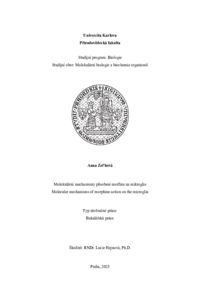Molekulární mechanismy působení morfinu na mikroglie
Molecular mechanisms of morphine action on the microglia
bachelor thesis (DEFENDED)

View/
Permanent link
http://hdl.handle.net/20.500.11956/199340Identifiers
Study Information System: 264878
Collections
- Kvalifikační práce [20869]
Author
Advisor
Referee
Vašek, Daniel
Faculty / Institute
Faculty of Science
Discipline
Molecular Biology and Biochemistry of Organisms
Department
Department of Physiology
Date of defense
3. 6. 2025
Publisher
Univerzita Karlova, Přírodovědecká fakultaLanguage
Czech
Grade
Very good
Keywords (Czech)
mikroglie, morfin, MOR, TLR4, opioidyKeywords (English)
microglia, morphine, MOR, TLR4, opioidsMorfin je hojně využíván pro svoje analgetické a sedativní schopnosti. To z něj činí důležitý lék pro léčení chronických a silných bolestí. Kromě svých pozitivních účinků má zejména dlouhodobé podávání morfinu i své nevýhody, jako je rychlý rozvoj tolerance a závislosti na něm. Morfin působí nejen na neurony, ale ovlivňuje i další buněčné typy jako jsou mikroglie. Mikroglie jsou důležité pro udržování homeostáze a jsou součástí neuroimunitního systému, tudíž mají zásadní roli při infekci, poranění nebo při nemocech centrální nervové soustavy. Ukazuje se, že morfin se může přímo vázat na opioidní receptory a toll-like receptory mikroglií a vyvolávat u nich procesy, které ovlivňují jejich vlastnosti jako chemotaxe a fagocytóza. Také má vliv na míru aktivace mikroglií, která je spojena s produkcí NO a zánětlivých cytokinů. Bylo prokázáno, že modulace aktivity mikroglií morfinem má vliv i na vnímání bolesti či na rozvoj tolerance a závislosti. Tyto jevy patří mezi hlavní oblasti výzkumů v oblasti opioidů, proto je cílem práce představit poznatky o působení morfinu na mikroglie. Klíčová slova: mikroglie, morfin, MOR, TLR4, opioidy
Morphine is widely used for its analgesic and sedative properties. This makes it an important drug for the treatment of chronic and severe pain. In addition to its positive effects, long-term administration of morphine also has its disadvantages, such as the rapid development of tolerance and dependence. Morphine acts not only on neurons, but also affects other cell types such as microglia. Microglia are important for maintaining homeostasis and are a part of the neuroimmune system, therefore they play a crucial role in infection, injury or diseases of the central nervous system. It turns out that morphine can directly bind to opioid receptors and toll- like receptors to induce processes in microglia that affect their function such as chemotaxis and phagocytosis. It also affects the degree of their activation, which is associated with the production of NO and inflammatory cytokines. This also affects the perception of pain or the development of tolerance. This is one of the main areas of research in the field of opioids, therefore the aim of the paper is to present findings on the effects of morphine on microglia. Key words: microglia, morphine, MOR, TLR4, opioids
